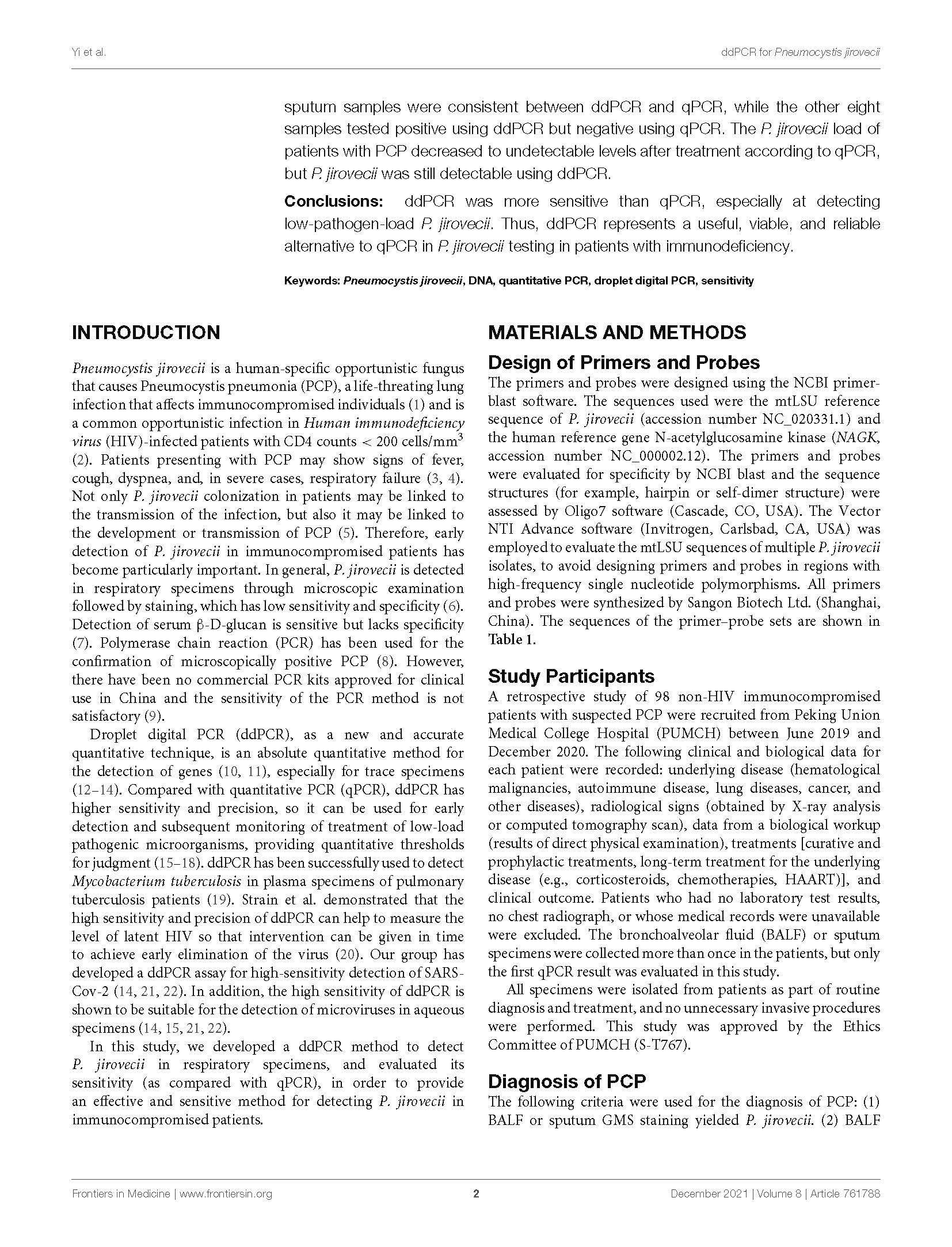Development of a Droplet Digital Polymerase Chain Reaction for Sensitive Detection of Pneumocystis jirovecii in Respiratory Tract Specimens
release date:2021-12-22

Background: Pneumocystis jirovecii is a human-specific opportunistic fungus that causes Pneumocystis pneumonia (PCP), a life-threatening opportunistic lung infection that affects immunocompromised patients. P. jirovecii colonization may be linked to the transmission of the infection. The detection of P. jirovecii in immunocompromised patients is thus especially important. The low fungal load and the presence of PCR inhibitors limit the usefulness of quantitative PCR (qPCR) for accurate absolute quantification of P. jirovecii in specimens. Droplet digital PCR (ddPCR), however, presents a methodology that allows higher sensitivity and accuracy. Here, we developed a ddPCR method for detecting P. jirovecii DNA in respiratory specimens, and evaluated its sensitivity against qPCR.
Materials and Methods: One bronchoalveolar fluid (BALF) sample each was collected from 82 patients with potential PCP to test the presence of P. jirovecii DNA using both ddPCR and qPCR, and samples with inconsistent results between the two methods were further tested by metagenomic next generation sequencing (mNGS). In addition, 37 sputum samples from 16 patients diagnosed with PCP, as well as continuous respiratory tract specimens from nine patients with PCP and treated with sulfonamides, were also collected for P. jirovecii DNA testing using both ddPCR and qPCR.
Results: ddPCR and qPCR gave the same results for 95.12% (78/82) of the BALF samples. The remaining four specimens tested positive using ddPCR but negative using qPCR, and they were found to be positive by mNGS. Detection results of 78.37% (29/37) sputum samples were consistent between ddPCR and qPCR, while the other eight samples tested positive using ddPCR but negative using qPCR. The P. jirovecii load of patients with PCP decreased to undetectable levels after treatment according to qPCR, but P. jirovecii was still detectable using ddPCR.
Conclusions: ddPCR was more sensitive than qPCR, especially at detecting low-pathogen-load P. jirovecii. Thus, ddPCR represents a useful, viable, and reliable alternative to qPCR in P. jirovecii testing in patients with immunodeficiency.
See all:
doi: 10.3389/fmed.2021.761788
 Background: Pneumocystis jirovecii is a human-specific opportunistic fungus that causes Pneumocystis pneumonia (PCP), a life-threatening opportunistic lung infection that affects immunocompromised patients. P. jirovecii colonization may be linked to the transmission of the infection. The detection of P. jirovecii in immunocompromised patients is thus especially important. The low fungal load and the presence of PCR inhibitors limit the usefulness of quantitative PCR (qPCR) for accurate absolute quantification of P. jirovecii in specimens. Droplet digital PCR (ddPCR), however, presents a methodology that allows higher sensitivity and accuracy. Here, we developed a ddPCR method for detecting P. jirovecii DNA in respiratory specimens, and evaluated its sensitivity against qPCR.
Background: Pneumocystis jirovecii is a human-specific opportunistic fungus that causes Pneumocystis pneumonia (PCP), a life-threatening opportunistic lung infection that affects immunocompromised patients. P. jirovecii colonization may be linked to the transmission of the infection. The detection of P. jirovecii in immunocompromised patients is thus especially important. The low fungal load and the presence of PCR inhibitors limit the usefulness of quantitative PCR (qPCR) for accurate absolute quantification of P. jirovecii in specimens. Droplet digital PCR (ddPCR), however, presents a methodology that allows higher sensitivity and accuracy. Here, we developed a ddPCR method for detecting P. jirovecii DNA in respiratory specimens, and evaluated its sensitivity against qPCR.